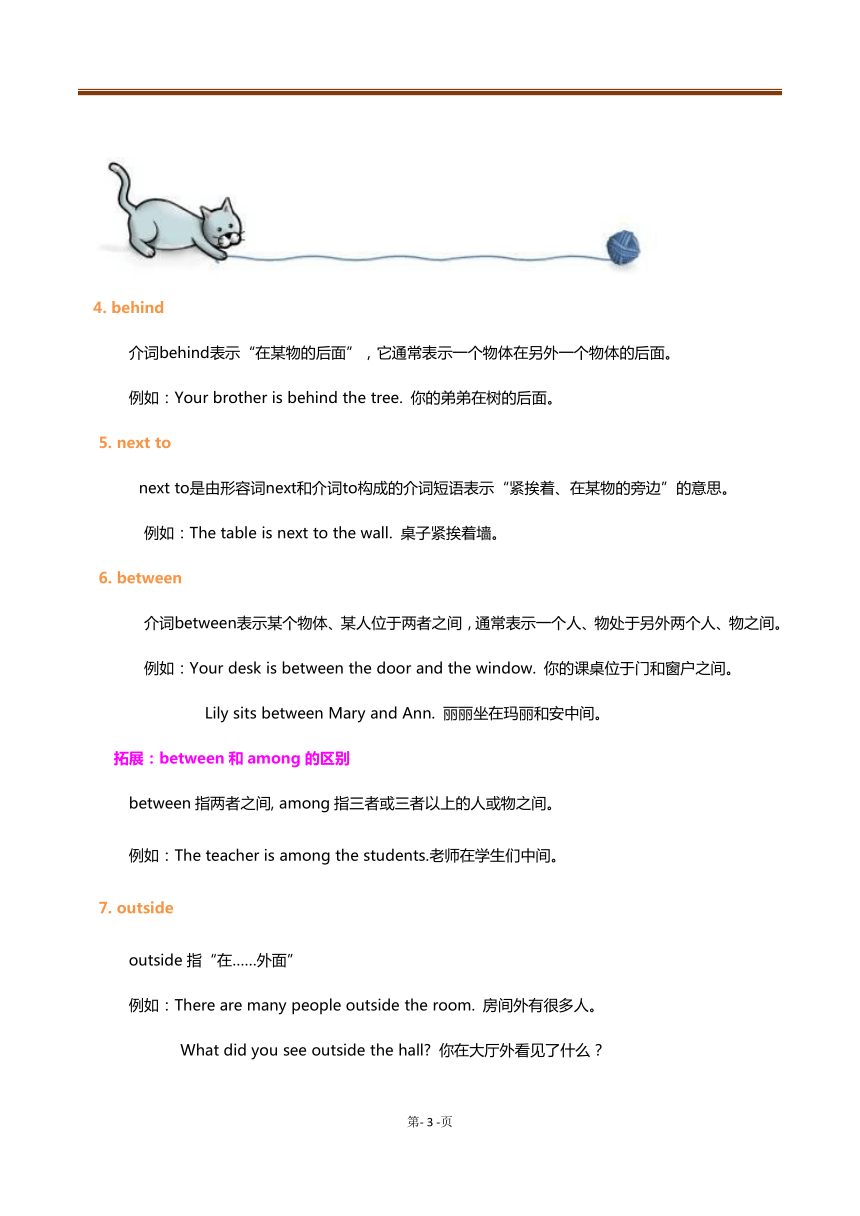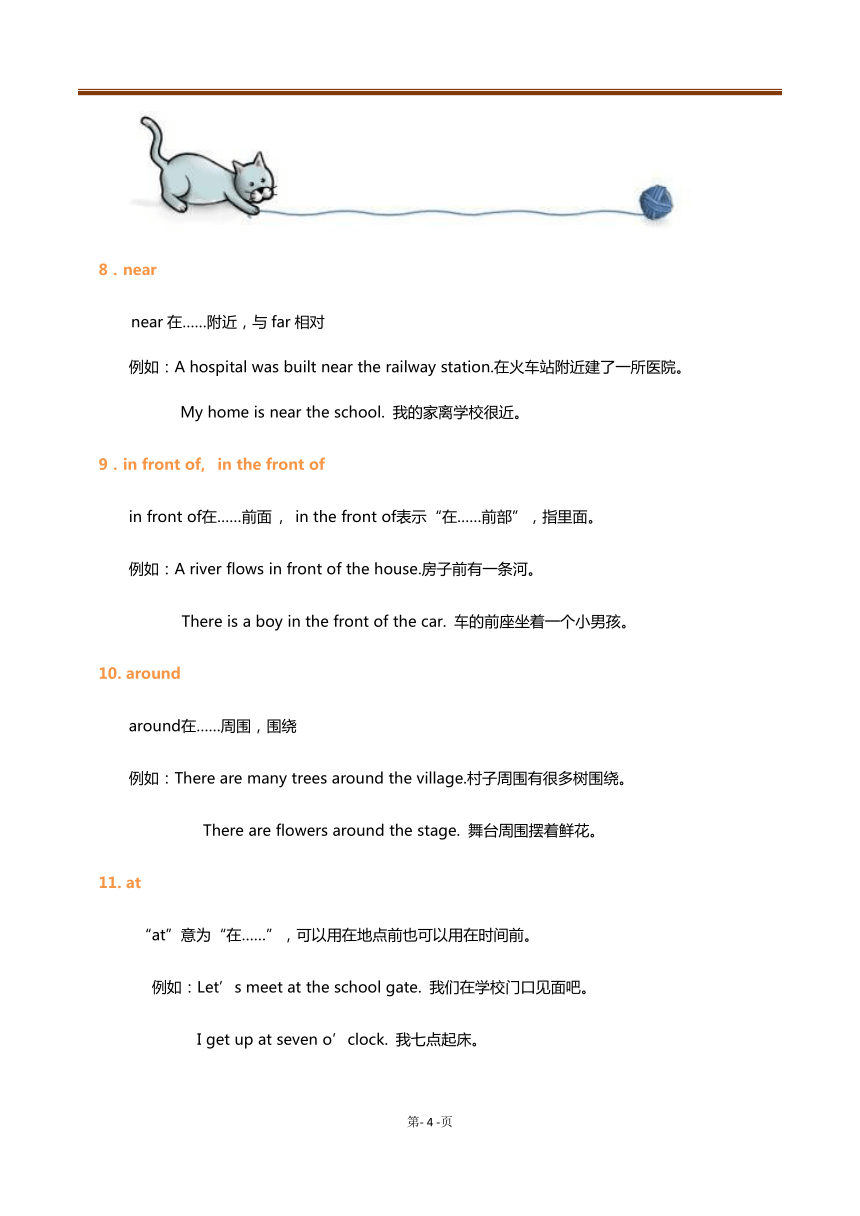2020-2021学年牛津译林初中英语七年级下学期Unit 4 Finding your way语法 方位介词(含答案)
文档属性
| 名称 | 2020-2021学年牛津译林初中英语七年级下学期Unit 4 Finding your way语法 方位介词(含答案) |  | |
| 格式 | zip | ||
| 文件大小 | 321.6KB | ||
| 资源类型 | 教案 | ||
| 版本资源 | 牛津译林版 | ||
| 科目 | 英语 | ||
| 更新时间 | 2021-04-20 11:50:20 | ||
图片预览





文档简介
学员编号:
年
级:七年级
课
时
数:
3
学员姓名:
辅导科目:
英语
学科教师:
授课类型
T
知识梳理
C
典例练习
T
方法总结
授课日期及时段
2020年
方位的介词的用法
本单元学习介词+定冠词the+名词构成介词短语的用法,介词后面可以跟名词和代词做宾语,构成介词短语。今天我们主要学习一下用来表示方位的介词和介词短语。
方位的介词的用法:
1.
on
介词on表示“在某物之上”的意思,它通常表示一个物体在另一个物体之表面上面。两者之间有接触。
例如:Your
book
is
on
the
desk.
你的书在课桌上面。
2.
in
介词in表示“在某物的里面”,它通常表示一个物体在另外一个物体的内部、中间或者在某个范围之内。
例如:Your
pen
is
in
the
pencil
case.
你的钢笔在铅笔盒里面。
3.
under
介词under表示“在某物的下面”,它通常表示一个物体在另外一个物体的垂直正下面,两者之间没有接触。
例如:My
bike
is
under
the
tree.
我的自行车在树的下面。
The
shoes
are
under
the
chair.
鞋在椅子的下面。
拓展:under和below
的区别
under表示“在……之下”,通常表示位置处于正下方,与介词over“在……上方”相对应。
例如:?There
is
a
book
under
the
table.
桌子下面有一本书。 ?
below表示“在……之下”,“在……的下游”,与介词above相对应,常指在某物体之下,但不一定在该物的正下方。
例如:He?is?below?the?average?at?school.他的学习成绩在水准以下。?
?4.
behind
介词behind表示“在某物的后面”,它通常表示一个物体在另外一个物体的后面。
例如:Your
brother
is
behind
the
tree.
你的弟弟在树的后面。
5.
next
to
next
to是由形容词next和介词to构成的介词短语表示“紧挨着、在某物的旁边”的意思。
例如:The
table
is
next
to
the
wall.
桌子紧挨着墙。
6.
between
介词between表示某个物体、某人位于两者之间,通常表示一个人、物处于另外两个人、物之间。
例如:Your
desk
is
between
the
door
and
the
window.
你的课桌位于门和窗户之间。
Lily
sits
between
Mary
and
Ann.
丽丽坐在玛丽和安中间。
拓展:between和among的区别
between指两者之间,
among指三者或三者以上的人或物之间。
例如:The
teacher
is
among
the
students.老师在学生们中间。
7.
outside
outside指“在……外面”
例如:There
are
many
people
outside
the
room.
房间外有很多人。
???
What
did
you
see
outside
the
hall?
你在大厅外看见了什么?
8.near
near在……附近,与far相对
例如:A
hospital
was
built
near
the
railway
station.在火车站附近建了一所医院。
???
My
home
is
near
the
school.
我的家离学校很近。
9.in
front
of,?
in
the
front
of
in
front
of在……前面
,?
in
the
front
of表示“在……前部”,指里面。
例如:A
river
flows
in
front
of
the
house.房子前有一条河。
?????
There
is
a
boy
in
the
front
of
the
car.
车的前座坐着一个小男孩。
10.
around
around在……周围,围绕
例如:There
are
many
trees
around
the
village.村子周围有很多树围绕。
???
There
are
flowers
around
the
stage.
舞台周围摆着鲜花。
11.
at
“at”意为“在……”,可以用在地点前也可以用在时间前。
例如:Let’s
meet
at
the
school
gate.
我们在学校门口见面吧。
I
get
up
at
seven
o’clock.
我七点起床。
用under和below
填空
There
is
a
book
______________________the
table.
He?is?
_
_______
?the?average?at?school.
under和below
的区别
用between和among填空
Lily
sits
Mary
and
Ann.
The
teacher
is
the
students.
between和among的区别
用in
front
of和in
the
front
of填空
A
river
flows
the
house.
There
is
a
boy
the
car.
in
front
of和in
the
front
of的区别
Ⅰ.
把下列词组翻译成英语。
1.
在沙发上____________________
2.
在桌子底下_____________________
3.在你的背包里____________________
4.
在抽屉里___________________
5.
在教室(外部)前面____________________
Ⅱ.
单项选则。
1.
Your
computer
is
______
to
the
door.
A.
behind
B.
on
C.
in
D.
next
2
The
map
is
____
the
wall
____
our
classroom.
A.
on;
on
B.
of;
on
C.
on;
at
D.
on;
of
3
Look!
The
window
is
_____
the
wall
and
the
picture
is
_____
the
wall.
A.
on;
on
B.
in;
in
C.
in;
on
D.
on;
in
4
-Where
is
my
ball?
I
can’t
see
it.
Look!
It’s
_____
the
door.
A.
on
B.
in
C.
at
D.
behind
5.
Sally
is
very
happy.
There
is
a
big
smile
______
her
face.
A.
on
B.
to
C.
in
D.
at
【答案与解析】
Ⅰ.
把下列词组翻译成英语。
1.
on
the
sofa
2.
under
the
table
3.
in
your
backpack
4.
in
the
drawer
5.
in
front
of
the
classroom
Ⅱ.
单项选择。
1.
D。本句子是考查介词的用法,但是,介词behind,on,in的后面用冠词the和名词、冠词、介词短语,不和to连用,所以本句子是用形容词next和to连用表示“紧挨着、在旁边”的意思。
2.
D。本句子用介词on和冠词the,名词wall构成介词短语表示“在墙上”的意思,后面用介词of构成名词所有格,表示所属关系,表示无生命的名词所有格的形式用of,而不用’s形式。
3.
C。本句子是考查介词的用法,表示在某物的表面之上用介词on;表示在某物内部用介词in。窗户是在墙的里面所以用介词in;画是贴在墙的表面上,与墙接触,所以用介词on。
4.
D。从对话前面的句子I
can’t
see
it.和问句可以判断后面的句子是用介词behind表示“在门的后面”,所以选择D是比较符合对话的上下句子意思和情景。
5.
A。句意:“Sally
非常开心,她脸上满脸微笑。”“在……上”用介词on。
Ⅰ.用适当的介词填空。
1.
A
boy
is
_________
the
tree.
2.
Can
you
pick(摘)
the
apples
___________
the
tree?
3.
There
is
a
picture
____________
the
wall.
4.
There
are
two
windows
____________
the
wall.
5.
I
live
____________
Shanghai.
Ⅱ.
单项选则。
1.
My
father
is
ill
(生病),
He
is
______.
A.
in
bed
B.
in
the
bed
C.
on
bed
D.
on
the
bed
2.
There
is
a
map
of
China
______
the
wall
in
the
classroom.
A.
in
B.
on
C.
under
D.
at
3.
There
are
three
windows
______
the
wall.
A.in
B.
on
C.
at
D.
to
4.
There
are
many
oranges
______
the
tree.
A
bird
______
the
tree
is
eating
an
orange.
A.
in;
on
B.
on;
on
C.
in;
in
D.
on;
in
5.
-What
time
do
you
usually
go
to
bed?
-I
usually
go
to
bed
______
11:00.
A.
in
B.
on
C.
at
D.
for
【真题链接】
1.
—My
green
ring
is
in
the
room.
What
about
yours?
—_________.
A.
It’s
red
B.
It’s
on
the
table
C.
It’s
Alice’s
2.
There
are
30
classrooms
____________
our
school.
Mine
is
_____________
the
second
floor.
A.
on;
in
B.
in;
in
C.
in;
on
D.
on;
on
3.
I
have
a
friend
and
my
friend
is
________
China.
A.
in
B.
at
C.
on
D.
under
【答案与解析】
Ⅰ.
用适当的介词填空。
1.
不是树上结的果实,表示某物在树上是要用in。
2.
树上结的果实“在树上”要用on。
3.
墙表面的上面,用介词on。
4.
窗户是镶嵌在墙里的,故用介词in。
5.
住在哪里,用介词in。
Ⅱ.
单项选择。
1.
A。in
bed
表示“卧床(睡觉)”,此时bed前无需加冠词。
2.
B。
地图在墙上,故用介词on。
3.
A。窗户是嵌在墙里面的,故应该用介词in。
4.
D。长在树上的东西用on;外来的东西用in。
5.
C。点钟前用介词at。
【真题链接】
1.
B。由问句“你的耳环在哪?”可知,选择B,表示方位,意为“在桌子上”。
2.C。表示“在学校里”,用介词in;表示“在第几层楼上”,用介词on。
3.A。表示“在中国”,用介词in。
年
级:七年级
课
时
数:
3
学员姓名:
辅导科目:
英语
学科教师:
授课类型
T
知识梳理
C
典例练习
T
方法总结
授课日期及时段
2020年
方位的介词的用法
本单元学习介词+定冠词the+名词构成介词短语的用法,介词后面可以跟名词和代词做宾语,构成介词短语。今天我们主要学习一下用来表示方位的介词和介词短语。
方位的介词的用法:
1.
on
介词on表示“在某物之上”的意思,它通常表示一个物体在另一个物体之表面上面。两者之间有接触。
例如:Your
book
is
on
the
desk.
你的书在课桌上面。
2.
in
介词in表示“在某物的里面”,它通常表示一个物体在另外一个物体的内部、中间或者在某个范围之内。
例如:Your
pen
is
in
the
pencil
case.
你的钢笔在铅笔盒里面。
3.
under
介词under表示“在某物的下面”,它通常表示一个物体在另外一个物体的垂直正下面,两者之间没有接触。
例如:My
bike
is
under
the
tree.
我的自行车在树的下面。
The
shoes
are
under
the
chair.
鞋在椅子的下面。
拓展:under和below
的区别
under表示“在……之下”,通常表示位置处于正下方,与介词over“在……上方”相对应。
例如:?There
is
a
book
under
the
table.
桌子下面有一本书。 ?
below表示“在……之下”,“在……的下游”,与介词above相对应,常指在某物体之下,但不一定在该物的正下方。
例如:He?is?below?the?average?at?school.他的学习成绩在水准以下。?
?4.
behind
介词behind表示“在某物的后面”,它通常表示一个物体在另外一个物体的后面。
例如:Your
brother
is
behind
the
tree.
你的弟弟在树的后面。
5.
next
to
next
to是由形容词next和介词to构成的介词短语表示“紧挨着、在某物的旁边”的意思。
例如:The
table
is
next
to
the
wall.
桌子紧挨着墙。
6.
between
介词between表示某个物体、某人位于两者之间,通常表示一个人、物处于另外两个人、物之间。
例如:Your
desk
is
between
the
door
and
the
window.
你的课桌位于门和窗户之间。
Lily
sits
between
Mary
and
Ann.
丽丽坐在玛丽和安中间。
拓展:between和among的区别
between指两者之间,
among指三者或三者以上的人或物之间。
例如:The
teacher
is
among
the
students.老师在学生们中间。
7.
outside
outside指“在……外面”
例如:There
are
many
people
outside
the
room.
房间外有很多人。
???
What
did
you
see
outside
the
hall?
你在大厅外看见了什么?
8.near
near在……附近,与far相对
例如:A
hospital
was
built
near
the
railway
station.在火车站附近建了一所医院。
???
My
home
is
near
the
school.
我的家离学校很近。
9.in
front
of,?
in
the
front
of
in
front
of在……前面
,?
in
the
front
of表示“在……前部”,指里面。
例如:A
river
flows
in
front
of
the
house.房子前有一条河。
?????
There
is
a
boy
in
the
front
of
the
car.
车的前座坐着一个小男孩。
10.
around
around在……周围,围绕
例如:There
are
many
trees
around
the
village.村子周围有很多树围绕。
???
There
are
flowers
around
the
stage.
舞台周围摆着鲜花。
11.
at
“at”意为“在……”,可以用在地点前也可以用在时间前。
例如:Let’s
meet
at
the
school
gate.
我们在学校门口见面吧。
I
get
up
at
seven
o’clock.
我七点起床。
用under和below
填空
There
is
a
book
______________________the
table.
He?is?
_
_______
?the?average?at?school.
under和below
的区别
用between和among填空
Lily
sits
Mary
and
Ann.
The
teacher
is
the
students.
between和among的区别
用in
front
of和in
the
front
of填空
A
river
flows
the
house.
There
is
a
boy
the
car.
in
front
of和in
the
front
of的区别
Ⅰ.
把下列词组翻译成英语。
1.
在沙发上____________________
2.
在桌子底下_____________________
3.在你的背包里____________________
4.
在抽屉里___________________
5.
在教室(外部)前面____________________
Ⅱ.
单项选则。
1.
Your
computer
is
______
to
the
door.
A.
behind
B.
on
C.
in
D.
next
2
The
map
is
____
the
wall
____
our
classroom.
A.
on;
on
B.
of;
on
C.
on;
at
D.
on;
of
3
Look!
The
window
is
_____
the
wall
and
the
picture
is
_____
the
wall.
A.
on;
on
B.
in;
in
C.
in;
on
D.
on;
in
4
-Where
is
my
ball?
I
can’t
see
it.
Look!
It’s
_____
the
door.
A.
on
B.
in
C.
at
D.
behind
5.
Sally
is
very
happy.
There
is
a
big
smile
______
her
face.
A.
on
B.
to
C.
in
D.
at
【答案与解析】
Ⅰ.
把下列词组翻译成英语。
1.
on
the
sofa
2.
under
the
table
3.
in
your
backpack
4.
in
the
drawer
5.
in
front
of
the
classroom
Ⅱ.
单项选择。
1.
D。本句子是考查介词的用法,但是,介词behind,on,in的后面用冠词the和名词、冠词、介词短语,不和to连用,所以本句子是用形容词next和to连用表示“紧挨着、在旁边”的意思。
2.
D。本句子用介词on和冠词the,名词wall构成介词短语表示“在墙上”的意思,后面用介词of构成名词所有格,表示所属关系,表示无生命的名词所有格的形式用of,而不用’s形式。
3.
C。本句子是考查介词的用法,表示在某物的表面之上用介词on;表示在某物内部用介词in。窗户是在墙的里面所以用介词in;画是贴在墙的表面上,与墙接触,所以用介词on。
4.
D。从对话前面的句子I
can’t
see
it.和问句可以判断后面的句子是用介词behind表示“在门的后面”,所以选择D是比较符合对话的上下句子意思和情景。
5.
A。句意:“Sally
非常开心,她脸上满脸微笑。”“在……上”用介词on。
Ⅰ.用适当的介词填空。
1.
A
boy
is
_________
the
tree.
2.
Can
you
pick(摘)
the
apples
___________
the
tree?
3.
There
is
a
picture
____________
the
wall.
4.
There
are
two
windows
____________
the
wall.
5.
I
live
____________
Shanghai.
Ⅱ.
单项选则。
1.
My
father
is
ill
(生病),
He
is
______.
A.
in
bed
B.
in
the
bed
C.
on
bed
D.
on
the
bed
2.
There
is
a
map
of
China
______
the
wall
in
the
classroom.
A.
in
B.
on
C.
under
D.
at
3.
There
are
three
windows
______
the
wall.
A.in
B.
on
C.
at
D.
to
4.
There
are
many
oranges
______
the
tree.
A
bird
______
the
tree
is
eating
an
orange.
A.
in;
on
B.
on;
on
C.
in;
in
D.
on;
in
5.
-What
time
do
you
usually
go
to
bed?
-I
usually
go
to
bed
______
11:00.
A.
in
B.
on
C.
at
D.
for
【真题链接】
1.
—My
green
ring
is
in
the
room.
What
about
yours?
—_________.
A.
It’s
red
B.
It’s
on
the
table
C.
It’s
Alice’s
2.
There
are
30
classrooms
____________
our
school.
Mine
is
_____________
the
second
floor.
A.
on;
in
B.
in;
in
C.
in;
on
D.
on;
on
3.
I
have
a
friend
and
my
friend
is
________
China.
A.
in
B.
at
C.
on
D.
under
【答案与解析】
Ⅰ.
用适当的介词填空。
1.
不是树上结的果实,表示某物在树上是要用in。
2.
树上结的果实“在树上”要用on。
3.
墙表面的上面,用介词on。
4.
窗户是镶嵌在墙里的,故用介词in。
5.
住在哪里,用介词in。
Ⅱ.
单项选择。
1.
A。in
bed
表示“卧床(睡觉)”,此时bed前无需加冠词。
2.
B。
地图在墙上,故用介词on。
3.
A。窗户是嵌在墙里面的,故应该用介词in。
4.
D。长在树上的东西用on;外来的东西用in。
5.
C。点钟前用介词at。
【真题链接】
1.
B。由问句“你的耳环在哪?”可知,选择B,表示方位,意为“在桌子上”。
2.C。表示“在学校里”,用介词in;表示“在第几层楼上”,用介词on。
3.A。表示“在中国”,用介词in。
